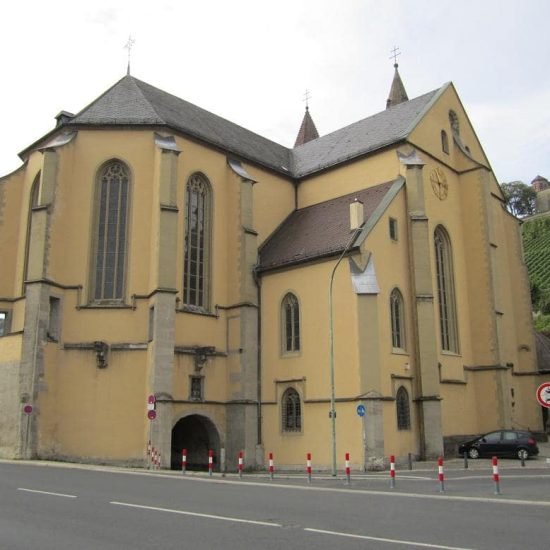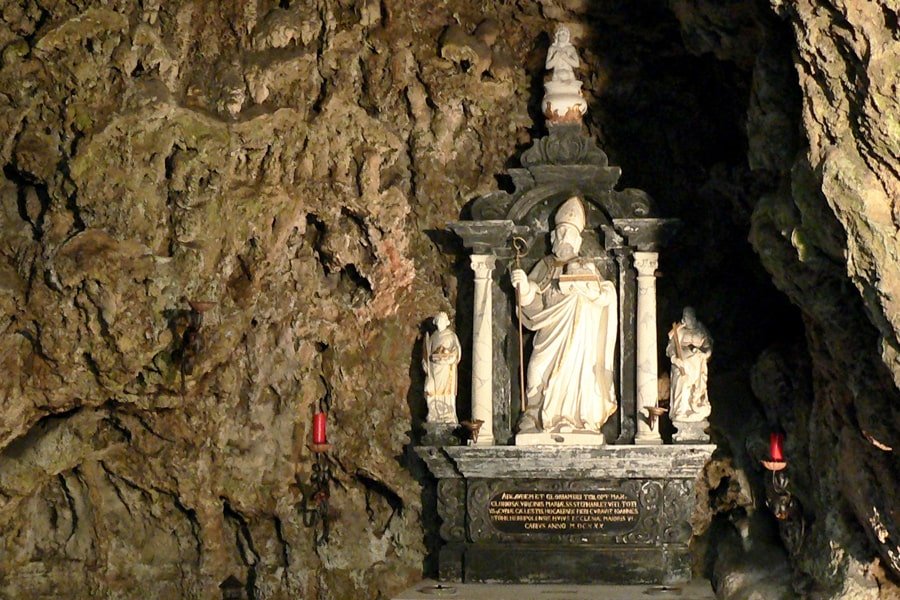The Benedictine Monastery St. Burkard
per person
The Benedictine Abbey St. Burkard in Würzburg has its origin in the Andreas Monastery which was founded in 748 by St. Burkard, the first bishop of Würzburg. Over the course of the 10th century, the impoverished Benedictine monastery was abandoned until it was rebuilt and revived by Bishop Hugo in 986. Similtaneously, the monastery also recieved the bones of St. Burkard and was renamed into St. Burkardus Monastery. Around the year 1000, the old monastery building was destroyed by a fire. The monastery, including its church St. Burkard, was rebuilt at a different place in a romanesque style under Abbot Willemund in the years 1033-1042. After the construction was finished, the new building was consecrated by Bishop Bruno in the presence of Emperor Heinrich III.
Further building activities include a portal vestibule that was added to the church 1180 as well the raising of the two east towers by two levels in 1250. During the late Middle Ages, the inhabitants of the monastery lived increasingly detached from the Rule of Saint Benedict, which lead to the conversion of the monastery into a collegiate church in 1464. In 1490, the romanesque church building was complemented by the late gothic transept and the east choir, although the interior was only largely furnished during the mid-16th century. After the secularization in 1803, the collegiate was dissolved and the church became property of the local parish. Nowadays, St. Burkard‘s church is the only building of the former monastery that is still intact.
FORMAL ANALYSIS
After a great fire in 1030, the altomedieval church was rebuilt in its present location. The oldest Romanesque area of the church was built by Abbot Willemund from 1033 and on Whit Monday 1042 in the presence of King Henry III and consecrated by Bishop Bruno. Between 1168-80 the vestibule of the portal (call “paradise») was added. Abbot Konrad had the polygonal upper stories of the two eastern towers built with the stone hulls of the tower around 1250.
The church was part of the Benedictine monastery, which became the spiritual knights’ monastery of St. Burkard in 1464. In 1464, it was transformed into a Stift. Under Provost Johann von Allendorf, the construction of the polygonal east choir with transept began in the 1490s. Its interior was not furnished until the middle of the 17th century. The old west choir was demolished under Prince Bishop Johann Philipp von Schönborn in the 1660s. The space was needed for new fortification walls and a circulation channel. Since the dissolution of the Stift in 1803, the abbey church has been used as the parish church of St. Burkard.
The Romanesque church was built in the 11th century. The Romanesque part of the nave has been preserved to this day, to which a Gothic choir and the upper part of the towers were added in the 13th and 14th centuries. In the church you can see a gothic triptych, decorated pews and baroque side altars.
FLORIAN HARTMANN
- THE BENEDICTINE MONASTERY ST. BURKARD© PHOT. https://wuerzburgwiki.de/w/index.php?curid=6966
- HISTORICAL ILLUSTRATION OF THE BURKORDER CHURCH IN THE MAINVIERTEL, DRAWING AND ENGRAVING BY JOHANN POPPEL, 1844© https://wuerzburgwiki.de/w/index.php?curid=16656
- ILLUSTRATION OF THE RECONSTRUCTION OF ST. BURKARD‘S CHURCH© PHOT. https://wuerzburgwiki.de/w/index.php?curid=23850
- HIGH ALTAR OF THE ST. BURKARD CHURCH© PHOT. https://wuerzburgwiki.de/w/index.php?curid=15583
- VIEW ON ST. BURKARD FROM THE FORTRESS MARIENBER© PHOT. Von Taken by Carport – Own Work, CC BY-SA 3.0, https:// commons.wikimedia.org/w/index.php?curid=7979116
- INTERIOR OF THE ROMANESQUE CHURCH© PHOT. https://www.tripadvisor.es/Attraction_Review-g187321-d2428678- Reviews-St_Burkard-Wurzburg_Lower_Franconia_Franconia_Bavaria.html
- ACCORDING TO LEGEND, BURKARD DIED IN THIS GROTTO IN HOMBURG AM MAIN© PHOT. Anja Legge, https://heilige.bistum-wuerzburg.de/heilige/hl-burkard/
Información de la localidad
The Benedictine Monastery St. Burkard
| Other monuments and places to visit | The Würzburg Residenz with its courtyard garden and Residenzplatz was listed as a UNESCO World Heritage Site in 1981; Falkenhaus, The Gothic Marienkapelle, The historic town hall, St. Kilian's catedral. |
| Natural Heritage | The Main, the region's most important watercourse, flows through the western part of the city. Its hillside location, climatic conditions and other locational factors make Würzburg a renowned wine-growing region. |
| Historical Recreations | |
| Festivals of Tourist Interest | |
| Fairs | |
| Tourist Office | No |
| Specialized Guides | No |
| Guided visits | No |
| Accommodations | Located close to the city centre, Würzburg offers numerous accommodation options. |
| Restaurants | Located close to the city centre, Würzburg offers numerous restaurants |
| Craft | No |
| Bibliography | Germania Benedictina 2: Die Männer- und Frauenklöster der Benediktiner in Bayern 1-3, hg. von der Bayerischen Benediktiner-Akademie, München 2014, S. 2584–2592 Wendehorst, Alfred/Benz, Stefan, Verzeichnis der Säkularkanonikerstifte der Reichskirche (Schriften des Zentralinstituts für Fränkische Landeskunde und Allgemeine Regionalforschung an der Universität Erlangen-Nürnberg 35), Neustadt an der Aisch 1997, S. 198 |
| Videos | Youtube |
| Website | st-burkard.de |
| Monument or place to visit | Monastery of St. Burkard |
| Style | Romanesque/Late Gothic/Baroque |
| Type | Monastic architecture |
| Epoch | 8th century/ 12th-13th century/15th to mid-16th century |
| State of conservation | Good condition |
| Mailing address | Pfarrei St. Burkard, Burkarder Straße 40, 97082 Würzburg |
| Coordinates GPS | 49°47′38″N 9°57′04″O |
| Property, dependency | Parish St. Burkard/ bishopric of Würzburg |
| Possibility of visits by the general public or only specialists | General public visits |
| Conservation needs | |
| Visiting hours and conditions | Not specified |
| Ticket amount | Free entry |
| Research work in progress | |
| Accessibility | Good |
| Signaling if it is registered on the route | |
| Bibliography | Backmund, N., 1973: Die Kollegiat- und Kanonissenstifte in Bayern, Windberg. Büll, F., 1993: ”Die Klöster Frankens bis zum neunten Jahrhundert”, Studien und Mitteilungen zur Geschichte des Benediktiner-Ordens und seiner Zweige 104, 9-40 |
| Videos | |
| Information websites | st-burkard.de de.wikipedia.org wuerzburgwiki.de wuerzburgwiki.de wuerzburgwiki.de wuerzburgwiki.de |
| Location | Würzburg, Bavaria |
















